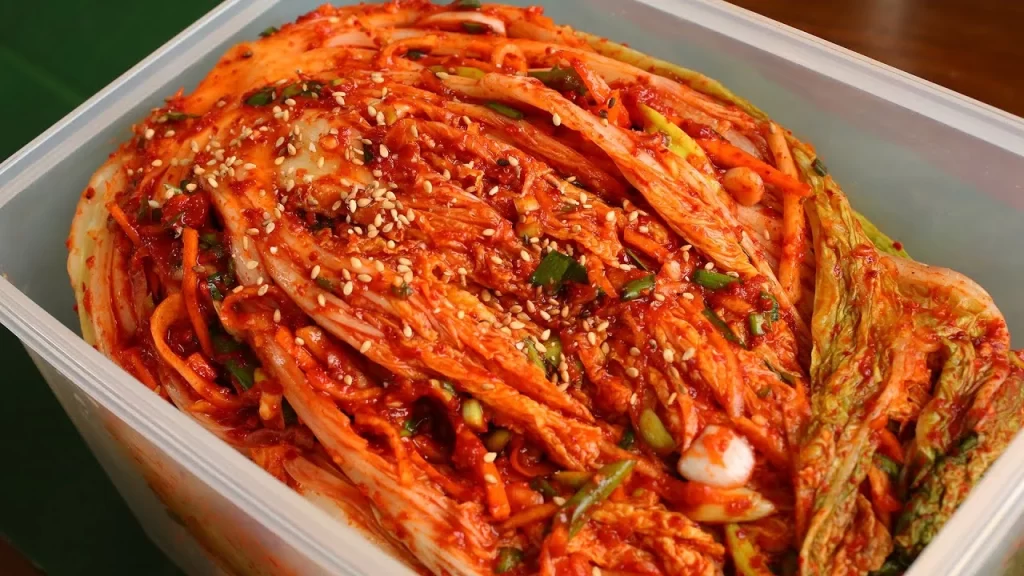Kimchi Craze: Unleash the Vibrant Flavors of Korea’s Superfood
Korean cuisine has long captured the hearts of people with its wonderfully spicy dishes prepared with the use of numerous spices. Now one of the Korean food trends is kimchi, a vitamin-rich and mouthwatering fermented vegetable side dish. This food is spicy and sour, and with the taste of umami, therefore, suitable for all dishes and snacks as a sauce and side dish . There are endless types of kimchi: regardless of which vegetables are fermented, the dish is saturated with health benefits only. The article provides information about kimchi – history, varieties, preparation, and specifics of the wild demand for the Korean product.
Table of Contents
ToggleThe Historical Roots of Kimchi
Ancient Beginnings and Cultural Significance
Kimchi hails from ancient Korea and was originally a means to store vegetables and eat them through the winter. In only a few hundred years, it has become a delicious fermented food that incorporates the best aspects of chili peppers, garlic, ginger, and fish sauce. Kimchi as we know it today became popular when chili peppers were first used in the 17th century. Kimchi has always been an essential meal in Korea to eat. This is because it is a sign of Ur’s persistence and solidarity. It is customary to prepare it in the company of family and relatives during festivities.
Evolution Through the Ages
As Korean society evolved, so did the varieties and flavors of kimchi, influenced by changes in agricultural practices, dietary preferences, and available ingredients. Today, there are over 200 known varieties of kimchi, tailored to different regional tastes and seasonal ingredients.

Crafting the Perfect Kimchi
The base of most kimchi recipes is napa cabbage or radish pimped with garlic, ginger, gochugaru , fish sauce, and jeotgal. Still, vegetarian versions are also ordinary. It is beneficial not only because of its taste, but these ingredients also hold most of the health benefits. The magic of Kimchi happens only at home. Each host is the master of one’s fermented, and they all vary in taste and time of fermentation, more sour in summer than in winter when the external temperature is more natural. Lactic-fermented cabbage is a well-known probiotic food because it contains too much good bacteria, lactobacillus.
Health Benefits of Kimchi
Nutritional Powerhouse
Kimchi is low in calories yet rich in dietary fiber, vitamins A, B, and C, and essential minerals like iron and calcium. Its main ingredient, cabbage, is known for its detoxifying qualities and cholesterol-lowering benefits.
Probiotic Properties
Due to its fermentation, kimchi is a natural probiotic, which helps promote a healthy gut flora. Regular consumption of kimchi can aid in digestion, enhance the immune system, and even help fight inflammation.
Kimchi in Culinary Practice
Versatility in Dishes
Kimchi can be enjoyed on its own or used as an ingredient in countless dishes. From traditional Korean recipes like kimchi jjigae (kimchi stew) and kimchi fried rice to modern culinary innovations such as kimchi tacos and kimchi burgers, the possibilities are endless.
Global Culinary Adaptations
As kimchi has gained popularity worldwide, chefs around the globe have begun incorporating it into a variety of dishes, showcasing its versatility and ability to enhance flavor profiles in unexpected ways.
The Global Popularity of Kimchi
Rise to International Fame
The global phenomenon behind Korean culture, including K-pop and Korean dramas, has led to the popularity of kimchi worldwide. The growing interest in Korean cuisines propels kimchi onto the global stage as people continue to enjoy the savory flavored dish that is good for their health.
The increasing popularity of foods that are fermented has made kimchi-making a global experience with chefs and homemakers sharing the process through workshops. Participants in these workshops learn the medicinal properties and nutritional value of kimchi in Korean culture.
Preserving Tradition While Innovating
Sustainable Practices in Kimchi Production
The need for more sustainable practices is becoming evident as global demand for kimchi increases. It involves the use of solely organic and natural ingredients, the reduction or repurposing of waste, and fair trade, particularly when it comes to unique Korean resources like gochugaru. However, more and more producers and craftsmen seem to concentrate on these factors to make kimchi not only good for health but also good for the environment and communities.
Innovations in Kimchi Varieties
Kimchi is still innovated, and chefs in cooperation with foodies try non-traditional fillings like kale, beetroot, or even fruits. In this way, kimchi is offered to representatives of other culinary habits and cultural backgrounds. Also, higher attention is given to vegan and allergen-free types of kimchi for everyone who prefers a plant-based food culture or has food allergies somehow .
Kimchi as Part of a Healthy Lifestyle
Diet Integration
Kimchi’s health benefits make it an excellent addition to any diet, promoting digestion, boosting immunity, and contributing to overall health with its vitamins and minerals. Integrating kimchi into daily meals can be simple, such as adding it to salads, sandwiches, or as a side dish to main courses.
Research on Health Benefits
Recent studies have highlighted the potential of kimchi in fighting conditions like obesity, high cholesterol, and even certain inflammatory disorders. These studies continue to fuel interest in kimchi not just as a food, but as a component of jpslot.
Educational Outreach and Cultural Exchange
Kimchi in Culinary Education
Culinary schools worldwide are beginning to include kimchi and other fermented foods in their curriculum, emphasizing the importance of traditional preservation techniques and the health benefits of fermented foods. This education helps new chefs understand global culinary traditions and how to incorporate them into diverse dishes.
Cultural Festivals and Kimchi Competitions
Cultural festivals around the world often feature kimchi, introducing it to new audiences through tastings, competitions, and educational booths. These events celebrate kimchi’s cultural heritage and its place in global cuisine, fostering greater appreciation and understanding.

Marketing and Global Trends
Branding Kimchi for the Global Market
As kimchi becomes more popular internationally, effective branding strategies are essential. These include highlighting its health benefits, versatility, and cultural significance, which appeal to health-conscious consumers and those interested in culinary exploration.
The Rise of Fermented Foods
Kimchi is riding the wave of the rising popularity of fermented foods in the global market, viewed as both trendy and beneficial for health. This trend helps propel kimchi into different markets, from luxury dining segments to everyday grocery stores, making it more accessible to a wide audience.
The Enduring Legacy of Kimchi
Kimchi is far more than just a necessary measure of cultural Korea; it is a living exposition of how classic foods can discover new meaning and still flourish in an ever-changing universe. Kimchi, having just taken a trip from a community staple to a worldwide superfood, demonstrates the fact of its broad appeal and adaptability. It functions as a vibrant dish, ready to explore its deep taste and nourishment advantages.
Kimchi is a crucial, dynamic piece that grabs the interest of everyone in the culinary realm. Whether it is prepared for an authentic Korean recipe or integrated into an incomparable cook, it fulfills the senses, thrilling the taste buds to listen to a tale rooted in cultural heritage but seasoned with fresh, modern tastes. Hence, to be nourished by kimchi is not simply to partake in a meal; still, it is to journey through a globe bathed in love and acceptance that we all may share together.
Also read: Ethical Dilemmas: Balancing Principles in a Complex World
